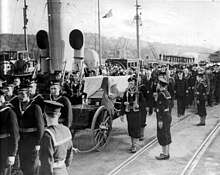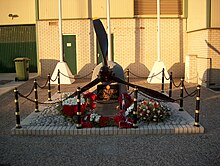Plane crash near Gibraltar (1943)
| Plane crash near Gibraltar (1943) | |
|---|---|
|
an identical aircraft |
|
| Accident summary | |
| Accident type | unexplained |
| place | Strait of Gibraltar |
| date | 4th July 1943 |
| Fatalities | 16 (probably) |
| Survivors | 1 |
| Aircraft | |
| Aircraft type | Consolidated C-87 |
| operator | Royal Air Force |
| Mark | AL 523 |
| Departure airport | Gibraltar airport |
| Passengers | 11 (probably) |
| crew | 6th |
| Lists of aviation accidents | |
The plane crash near Gibraltar was an aircraft accident on July 4, 1943 at 11:06 p.m. local time. A Consolidated Liberator of the Royal Air Force that had been converted into a transport aircraft crashed into the Strait of Gibraltar 16 seconds after take-off from Gibraltar Airport . 16 passengers and crew members were killed, including the Prime Minister of the Polish government-in-exile , Władysław Sikorski . Only the pilot Eduard Prchal survived and stated that the elevator was blocked.
The cause of the crash is unclear. Sabotage and an order to murder Sikorski are suspected to this day. There is no evidence of this.
Fatalities
- Poland
- Władysław Sikorski, Prime Minister of the Polish government in exile and Commander in Chief of the Polish Army in Exile .
- Zofia Leśniowska, Sikorski's daughter (not found)
- Tadeusz Klimecki , Chief of Staff of the Polish Army in Exile
- Jan Gralewski, courier for the Polish Home Army
- Adam Kułakowski, Adjutant (not found)
- Andrzej Marecki, Colonel, Chief of III. Operational department of the staff of the Commander in Chief of the Polish Army in Exile
- Józef Ponikiewski, lieutenant, adjutant to General Sikorski
- British
- Victor Cazalet , Col., communications officer, member of the House of Commons
- John Percival Whiteley , Brig., Member of the House of Commons, Advisor to the Viceroy of India
- WH Lock, civil person (not found)
- Mr. Pinder, civil person
- crew
- CB Gerrie, flight sergeant,
- William S. Herring, squadron leader (not found)
- D. Hunter, flight sergeant (not found)
- F. Kelly, sergeant
- L. Zalsberg, warrant officer
Official investigations
On July 7, 1943, the Royal Air Force set up a commission of inquiry made up of its own officers and only admitted one Polish officer as an observer without a say. After a few days, she announced her result in a brief letter to the Polish government in exile: The crash was due to a blocked elevator. The cause of the blockade cannot be clarified, but sabotage can be ruled out. The pilot was in no way responsible.
The Polish Air Force rejected this result: The British information was based only on the statements of the pilot and could not be verified, since only parts of the aircraft had been recovered. A commission of the Polish Ministry of Justice found: The available materials and testimonies neither clarified the cause of the accident nor did they prove sabotage . To do this, the aircraft must be fully lifted and thoroughly examined by independent experts. Until then, unknown causes would have to be assumed.
The contradicting British report led to the assumption that a crime was being covered up and to mutual suspicion between Poles and British, which the Nazi propaganda further fueled.
According to new testimony from 1967, the British government ordered a second investigation in 1969. She found that the aircraft had stood unguarded on the tarmac for a while and that an unknown person had entered it. Sabotage cannot therefore be ruled out.
In September 2008, the Polish State Institute for National Remembrance opened an investigation into Sikorski's cause of death on suspicion of a “ communist crime ”. From November 25, 2008, his body was exhumed and examined by forensic medicine using DNA analyzes and radiologically. No evidence of shooting, strangulation or poisoning was found, but 66 broken bones and organ damage caused by the fall. Accordingly, he died of these injuries or drowned afterwards.
The Polish prosecutors also wanted to see British secret files on Sikorski's death during this investigation, but they are to remain under lock and key until 2041. Alleged statements by deceased witnesses for a contract killing could not be proven. Sabotage or a deliberately induced emergency landing of the aircraft were still not ruled out.
Speculative murder theses
Because Sikorski wanted to have the Katyn massacre discovered at the beginning of April 1943 (perpetrated in 1940) investigated internationally, the Soviet dictator Josef Stalin threatened to break the anti-Hitler coalition . British Prime Minister Winston Churchill therefore tried to prevent Sikorski from turning on the IRK , but unsuccessfully. On April 25, 1943, Stalin broke off diplomatic relations with the Polish government in exile. Since then, it has repeatedly been suspected that Sikorski was murdered to prevent the Katyn massacre from being investigated.
In 1947 the Polish general Gustaw Paskiewicz publicly claimed that the Polish general Władysław Anders had asked him to participate in an assassination attempt on Sikorski. He refused. Sikorski was murdered because of his efforts to find a compromise with the Soviet Union. Historians believe the claims were part of a post-war campaign by the Polish communist government against Anders.
The Geschichtsrevisionist and later Holocaust deniers David Irving claimed in 1967, Churchill had them killed Sikorski. Rolf Hochhuth took up this thesis in his drama Soldiers (1967). He gave oral reports from several contemporary witnesses as the source. As a motive, he cited that the British government feared that Sikorski might “annoy Stalin out of the war into a separate peace with Berlin”. Other authors suspected British agent Kim Philby of plotting an assassination attempt on Sikorski. Philby was responsible for Gibraltar's security in 1943 and later proved to be a Soviet double agent .
The Argentine writer Carlos Thompson questioned all available witnesses of the crash and Hochhuth from 1967 to 1969. He came to the conclusion that Hochhuth had invented many of his statements and presented no facts. A witness who should have betrayed Churchill's murder assignment was nowhere to be found. Historians see no danger of a separate German-Soviet peace at the time, since Stalin had been counting on a victory over Adolf Hitler since the Battle of Stalingrad in early 1943 . After the discovery of the mass graves in Katyn in April 1943, Churchill had praised Sikorski in a letter to Stalin as "by far the most helpful man for the common goal" "whom you or we can find".
Several Polish authors have published variants of the murder thesis. The journalist and historian Dariusz Baliszewski assumes that Stalin, with knowledge, ordered Churchill to sabotage the aircraft, that the Soviet ambassador Iwan Maiski carried out this and that the surviving pilot faked a crash on behalf of the British secret service. The docu-drama Churchill's Betrayal of Poland (2011) described his clues.
Movies
- Churchill's betrayal of Poland. Germany 2011, directed by Christoph Weinert, Dierk Ludwig Schaaf. Information in the Internet Movie Database (English)
- Crash Over Gibraltar Poland 2009, directed by Anna Jadowska . Information in the Internet Movie Database (English)
- Dead Men's Secrets. The Mysterious Death of General Sikorski. History Channel 2002, information in the Internet Movie Database (English)
- Katastrofa w Gibraltarze. 1984, directed by Bohdan Poręba. Information in the Internet Movie Database (English)
- Silent Enemy. (German: Froschmann Crabb ) 1958. Director: William Fairchild. Information in the Internet Movie Database (shows, among other things, diving actions to search for victims after the crash)
- Niedokończona podróż. 1943, directed by Eugeniusz Cękalski. Information in the Internet Movie Database (English), table of contents
literature
- Tadeusz A. Kisielewski: Gibraltar i Katyń: co kryją archiwa rosyjskie i brytyjskie. Dom Wydawniczy Rebis, 2009, ISBN 8375104434 .
- Justin Whiteley: Śmierć generała Sikorskiego. Wyd. Bellona, 2007, ISBN 978-83-1110-921-6 .
- Tadeusz A. Kisielewski: Zamach. Tropem zabójców generała Sikorskiego. Dom Wydawniczy Rebis, Poznań 2005, ISBN 83-7301-767-4 .
- Jan Bartelski: Disasters in the Air: Mysterious Air Disasters Explained. Airlife, 2001, ISBN 978-1-84037-204-5 , pp. 26-57.
- Jan Bartelski: What did happen to General Sikorski? Airplane Monthly, I: September 1993, p. 12ff; II: October 1993, p. 44ff
- Wacław Subotkin: Tragiczny Lot Generała Sikorskiego, Fakty i Dokumenty. Krajowa Agencja Wydawnicza, Szczecin 1986, ISBN 83-03-01274-6 .
- Jerzy Klimkowski: Katastrofa w Gibraltarze: kulisy śmierci generała Sikorskiego. Śląsk, 1965
- Stanisław Strumph Wojtkiewicz: Sikorski i jego żołnierze. T. Lemański, 1946
Web links
- Der Spiegel, November 26, 2008: Second World War: How did General Sikorski die?
- Harry de Quetteville, (The Telegraph, July 1, 2008): Did British double agent Kim Philby murder Polish was hero General Sikorski?
- Dariusz Baliszewski (July 12, 2008): Było dwóch Sikorskich
- Dariusz Baliszewski (May 3, 2011): Churchill kazał zabić Sikorskiego? Niemiecki dramaturg ma dowód
Individual evidence
- ^ Tadeusz Kisielewski: Zamach. Tropem zabójców generała Sikorskiego. Poznań 2006, pp. 169–170.
- ^ Andrzej Paczkowski: The Spring Will Be Ours: Poland and the Poles from Occupation to Freedom. Pennsylvania State University, 2003, ISBN 0271023082 , p. 113 .
- ^ A b Hansard : Death of Members. UK Parliament, July 6, 1943. Retrieved September 11, 2019 .
- ^ Victim names in New York Times, July 6, 1943: Sikorski is killed in Airplane Crash; Others of 16 Dead Are Polish Premier's Daughter, Chief of Staff and Cazalet, MP (English, chargeable)
- ↑ Michael Alfred Peszke, Piotr Stefan Wandycz : . The Polish Underground Army, the Western Allies, and the Failure of Strategic Unity in World War II Mcfarland, 2004, ISBN 9780786420094 , pp 102-104 .
- ↑ Instytut Pamięci Narodowej (September 3, 2008): Śledztwo w sprawie śmierci generała Władysława Sikorskiego (Polish)
- ↑ BBC, January 29, 2009: No evidence Polish hero murdered ; Instytut Pamięci Narodowej: Śledztwo w sprawie katastrofy w Gibraltarze
- ^ Rainer Blasius: But a murder for reasons of state? Rolf Hochhuth is supposed to help Polish public prosecutor to solve the death of General Sikorski. FAZ, September 2, 2011
- ↑ procurator Oddziałowej Komisji ... ( Memento of 26 August 2014 Internet Archive ) (Instytut Pamięci Narodowej)
- ^ George Sanford: Katyn and the Soviet massacre of 1940: truth, justice and memory. 2005, p. 193.
- ^ Halik Kochanski: The Eagle Unbowed: Poland and the Poles in the Second World War. Penguin, 2013, ISBN 1846143586 , p. 347 .
- ^ David Irving: Accident - The Death of General Sikorski . 1967, ISBN 0-7183-0420-9 .
- ^ Rolf Hochhuth: Letter to Golo Mann. (Undated, early April 1967). In: Tilmann Lahme, Kathrin Lüssi (Ed.): Golo Mann: Briefe 1932-1992. Wallstein, 2006, ISBN 3835300032 , p. 410.
- ↑ Bruce Page, David Leitch, Philip Knightly: The Philby Conspiracy. (1969) 2nd edition, Ballantine Books, New York 1981, ISBN 0345297261 .
- ↑ Carlos Thompson: The Defamation of Winston Churchill. (1969) Droemer-Knaur, Munich / Zurich 1980, ISBN 3-426-03619-3 .
- ^ Roy Berkeley: A Spy's London. Pen and Sword, 1994, ISBN 1-4738-1160-0 , pp. 35 f.
- ^ Sarah Meiklejohn Terry: Poland's Place in Europe. General Sikorski and the Origin of the Oder-Neisse Line, 1939-1943. Princeton University Press, 2014, ISBN 1400857171 , p. 343 .


